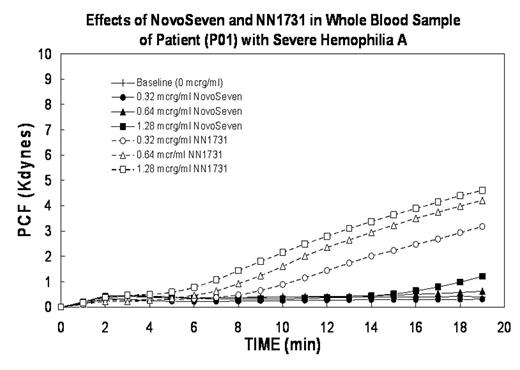Abstract
Purpose: The onset of force production due to thrombin generation (TGT), the amount of force produced (PCF) and the elastic modulus (CEM) of clots have been shown to be dose dependent functions of increasing recombinant FVIIa (rFVIIa) concentrations in a variety of patient blood samples. We performed a dose dependent comparison of the effects of rFVIIa and NN1731, an enhanced activity analogue of rFVIIa, in blood from normal volunteers and from hemophilia patients with and without factor VIII inhibitors.
Methods: Blood was obtained from six healthy controls, two patients with factor VIII deficiency, two patients with hemophilia and factor VIII inhibitors, and one patient with a spontaneous factor VIII inhibitor who were enrolled in an IRB approved study. The blood was spiked with increasing concentrations (0.32, 0.64, and 1.28 mcg/ml final) of either rFVIIa or NN1731. TGT, PCF and CEM were determined using the Hemodyne Hemostasis Analyzer.
Results: rFVIIa (1.28 mcg/ml) shortened the TGT (from 7 to 4 mins), increased CEM (from 20 to 31 Kdynes/cm2) and increased PCF (from 5.6 to 6.6 Kdynes) in blood from healthy controls. The effects of NN1731 (1.28 mcg/ml) were similar for CEM and PCF parameters (31 Kdynes/cm2; and 6.8 Kdynes, respectively; however, the effects were slightly more pronounced for TGT (2 mins). Due to the prolongation of TGT, and the decrease in PCF and CEM in all patient samples, the effects of both rFVIIa and NN1731 were much more pronounced. In all cases, both agents shortened the TGT, and increased both the CEM and PCF. In all patients NN1731 was considerably more potent but the dose response to both agents showed significant patient dependent variability. An example of this variability is illustrated below in the kinetics of PCF development of two patients with hemophilia. At baseline both patients had profoundly prolonged TGT (>20 mins) and no force development. Patient P01 showed minimal response to increasing doses of rFVIIa and good response to NN1731. Patient P02 showed a nice response to both agents.
Conclusions: This study suggests that recombinant analogue NN1731 of rFVIIa may be more potent than rFVIIa in correcting the thrombin generation, platelet function and clot structure deficiencies noted in patients with hemophilia with or without factor VIII inhibitors. Additionally, this study showed significant patient dependent variability at baseline and in response to both rFVIIa and NN1731.
Effects of NovoSeven and NN1731 in Whole Blood Sample of Patient (P01) with Severe Hemophilia A
Effects of NovoSeven and NN1731 in Whole Blood Sample of Patient (P01) with Severe Hemophilia A
Effects of NovoSeven and NN1731 in Whole Blood Sample of Patient (P02) with Severe Hemophilia A
Effects of NovoSeven and NN1731 in Whole Blood Sample of Patient (P02) with Severe Hemophilia A
Author notes
Corresponding author



This feature is available to Subscribers Only
Sign In or Create an Account Close Modal